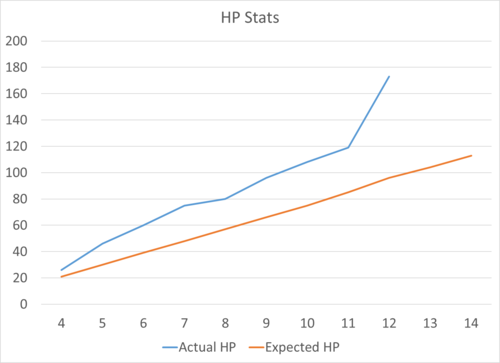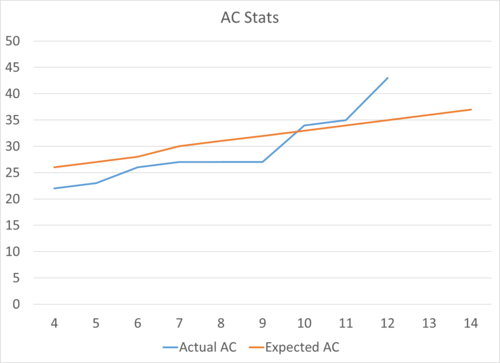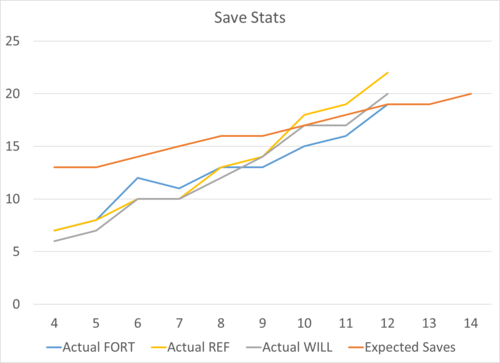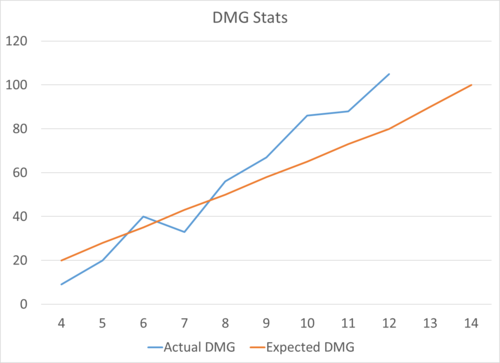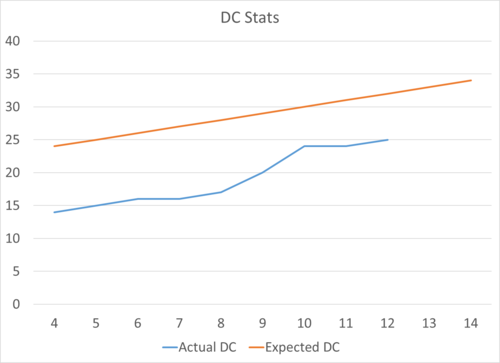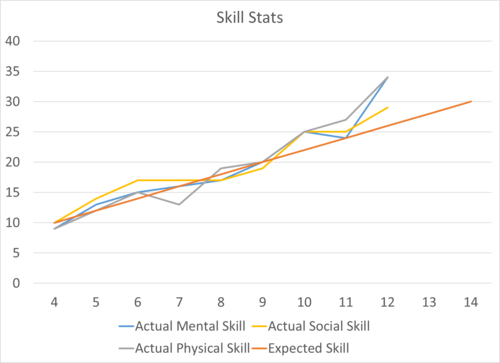3.P Character Creation Tutorial
The following is a step-by-step tutorial for creating a character in the Dungeons and Dragons 3.5 / Pathfinder (3.P) ruleset for use in the World of the Ledge. It's probably best to read through any sections you're not familiar with before you get started, and to open any links in a new tab.
(Note that this tutorial is a bit out of date - I've updated the checklists at least and added base stats for quick reference.)
Alternatively, if you'd prefer to just use a pre-made character, I'll list them here:
Nadir of Rrhos is a ruggedly-handsome, up-to-no-good Artifact Smuggler (Rogue / Bard) that wants to find the lost city of Urypt or just somewhere he can belong.
Players that want to just jump into character creation can use these level-up checklists:
Over the years, players have requested metrics by which to compare tiered gestalt characters. The following gives a breakdown of character averages by level:
For this tutorial, we'll use Nadir as an example 4th level character. I should note that players will have multiple opportunities to make and play characters, so it might be best to play it safe for your first one. Also as a note: the easiest way to build a character under these rules is to select a tier 1 class and then spend any extra CP on bonus feats or ability score increases. The second easiest is to start with a tier 2 or 3 class and gestalt that with another tier 3 class from first level. For general build advice, search online for the guides or handbooks for each class (take these with a grain of salt).
Concept & Rules Review
So you're a fan of Star Wars and Indiana Jones. You wish Harrison Ford had stayed young forever and that you could live that life. You're told by the Game Master that this isn't your typcial medieval fantasy sandbox, and that this continent especially isn't at all like Western Europe. So you throw "Harrison Ford" in an anagram solver and you get "Nadir of Rrhos". Sounds good.
Next it makes sense to review the 3.P ruleset:
- Dungeons and Dragons 3.5 System Reference Document
- Pathfinder System Reference Document
- Quick Summary of the Changes from 3.5 to Pathfinder
- Pathfinder RPG Conversion Guide
- A Guide to Free D&D
- D&D 3.5 Handbook Index
- The Comprehensive Pathfinder Guides Guide
- More Changes from 3.5 to Pathfinder
As well as the character creation house rules here (we'll address the parts relevant to character creation in this tutorial).
It's easy to get lost in the rules and forget that you're building a means to play with others. It's worthwhile to spend a moment thinking about what role you see the character playing in the group. In combat, and out. For example, the tank, healer, and striker are common combat roles, while the leader, lancer, and smart guy are common social roles. I've always liked Person_Man's breakdown of the roles here and the Spheres wiki has a good rundown here. None of these are set in stone, of course, and there's a fair amount of crossover between roles, but I find that everything tends to go more smoothly when players know their role and play to (or strategically against) their role. Just something to think about. Nadir sounds like a guy who likes to shoot first and ask questions later, so probably a striker / lancer type.
Deciding Classes, Races, and Description
I find it easier to decide on a character's classes first, and then to work backward. There's a lot of work involved with leveling each class, so let's just make the initial decisions now and we can fill in the blanks later.
Nadir's previous incarnations were a tomb raider and smuggler, with a mix of archeology and roguish tricks thrown in as well. He has elements of a lady-killer and delver of secrets too, so of the core classes Rogue and Bard sound like the best fit. Factotum, Gunslinger or Swashbucker might work as well. We know he uses a whip, probably a gun too, and relies on his dexterity and charsima to overcome most challenges. Likely just human, with dark hair and dashing good looks.
So let's start filling in the character sheet. At some point, it'll be a good idea to put the final stat block on the character's card here, or to fill in a sheet on Roll20 (or whatever online platform we're using), but for now it's fine to just use whatever type of sheet you're most comfortable with. I'll use Myth-weavers for convenience. Here's a copy of Nadir's sheet. You can find some description guidance here. Note that you'll need to choose a public and private alignment, and evil characters are allowed. If you want to make a portrait for Nadir, we've been given permission to use Hero Machine, so check that out. We'll go ahead and fill in some basic details (ignoring the XP sections for now).
Ability Scores and Age
These represent (or measure) your aptitude for achieving various tasks. The higher the better. Use the ability score point buy rules (rather than rolling, see here). No reason to needlessly gamble on a long-term investment. Use the High Fantasy amount of 20 points. We'll apply any modifications to your ability scores later.
Looking ahead, we imagine Nadir as a middle-aged character, which means that he'd receive a -1 to his physical stats and a +1 to his mental stats. This allows us to take advantage of the cheaper pricing for odd-numbered ability scores, so we spend our 20 points to give him a starting allocation something like this:
| STR | 11 |
| DEX | 15 |
| CON | 11 |
| INT | 13 |
| WIS | 11 |
| CHA | 15 |
After accounting for his age-based bonuses/penalties, adding the +2 from Human (still not final on this yet, add to Dex), and the +1 to an ability score at 4th level (add to Cha), we get the following:
| STR | 10 |
| DEX | 16 |
| CON | 10 |
| INT | 14 |
| WIS | 12 |
| CHA | 17 |
Notice that 10, 10, 12, 14, 14, 16 would normally cost more than 20 points, but with the odd-scores we were able to take advantage of some savings. We may change his age or race, or add a template or item that would change his stats, but this looks like a good baseline for now.
Note that the Pathfinder developers have ruled that the same ability score can't apply to the same statistic more than once (they're typed bonuses that don't stack).
Gender
Genders in the World of the Ledge don't directly affect your gameplay statistics, but there are some non-standard genders available anyway. See here. If you don't specify, I'll assume that your character is just default male or female (or we can always roll it).
Race & Templates
Fantasy races of all kinds can be found in the World of the Ledge, but one's race, in general, is only as important as one chooses for it to be. Cultural background and nationality typically play a larger role as factional divides drive conflict, but a character's ethnicity can still provide interesting opportunities for roleplaying. You'll have to play to learn more about the factions.
Nadir has been previously established as a human, possibly even a human paragon, so since that's also a strong option it seems naturally to stick with what works. Half-elf might be a consideration, if only because it provides useful favored class bonuses, but both are equally potent and human feels more flavorful. Let's record the standard human racial traits (noting the extra feat for later). There is no universal common language for the whole world, so Humans start with the language most common to their region. For A Maze of Grain that would be the Vei'Dathan language. The Ohmani Language comes a close second, so we'll probably choose that as a bonus langage. For more languages, see here:
Players are free to use the Pathfinder Race Builder to establish their own races, but keep the total race points used to 15. Anything more comes out of your Character Points on a 1-to-1 basis. We'll build a comprehensive race list soon, but the most common races in general are Human, Sauren, and Teotl. The setting for A Maze of Grain features Qin prominently, as well.
Templates cost a minimum of their cumulative ability score bonuses and penalties. So if you'd get a +4 Str and -2 Int, the template costs at minimum 2 CPs. Most templates are strong enough that they can increase a character's tier at low levels, but then they drop off in effectiveness in later levels. So typically you'll just pay a lump sum for a template, roughly equal to the level adjustment times the costs of the tier it would place you at. For example, the vampire template is considered fairly poor, around tier 5, but this is mostly on account of the high level adjustment (+8 in D&D 3.5). I'd price this at 8 x 2 CP = 16 CP. In Pathfinder, it's pegged at CR+2, so as an LA+2 template it might be tier 3, or 2 x 8 CP = 16 CP again. This also agrees with the minimum based on cumulative ability score bonuses/penalties (6+4+2+2+4=18, with the nonability in Con counting as at least -2). If you took the template progression slowly over several levels, I might treat it like it were a tier 5 class, so you'd only pay 1 for the first level, giving you a 1 point discount. Once you've paid for the template or progression, you pay CP costs as normal for your tier(s). You can always put the Level Adjusted levels from templates on another track, so they don't need to interrupt your other class levels (and gestalting class levels with LA gives you the BAB, Saves, and other bonuses of the class since the LA counts for zero). Don't go overboard with this and you should be fine. Note that I'll price high tier templates more.
First Class Levels
We've already figured Nadir as a Rogue / Bard, but let's go into the details of his first levels now. Note: Typically you'd write gestalt class levels like Rogue // Bard, with multiclassing using the regular slash. Since you can always take levels on a different track in tiered gestalt, there's no good way to indicate that except on a table, and multiclassing here isn't really different than gestalt, so Rogue / Bard is fine.
There aren't any alternate class features that seem to fit well, but the Smuggler and Archaeologist archytpes look perfect. At first level, we have 2 CPs, so we spend 1 CP to buy the Rogue level, and 1 CP to buy the Bard level (recording both tracks and their costs on a table somewhere). Our archetypes don't change any of our base statistics, so we can begin to record our BAB and Saves.
Both classes have a medium BAB, good reflex saves, and poor fortitude saves, so we record 0.75 as our base attack bonus, 2.5 as our base reflex save, and 0.33 as our base fortitude save (following the house rules for fractional BAB and saves). Bards have a good will save, while Rogues have a poor one, so we go with the higher bonus of 2.5. Hite Die are the same (d8) and we get max Hit Points at first level, so we record an 8. Rogues have more skill points, so we can put 8+2+1=11 down ready to be allocated (I usually record this at the bottom of the skill list first, don't forget human bonus skill points). While we're looking at skills, we can mark the class skills for each class (just check off each item on both lists). For example, it looks like in the case of Nadir, all standard skills but Fly, Handle Animal, Heal, Ride, and Survival are class skills since the Rogue and Bard already cover a lot. We might pick up more later, so we'll wait to fill in our skill ranks. Similar to class skills, we can add all the weapon and armor proficiencies together and record them (for convenience, I typically use one column for feats, and another for class/race features). We'll choose rogue as our favored class, so we can use the human option of +1/6th of a rogue trick per level (we can record the fraction now).
Moving on to the other class features, we'd better be careful that we keep track of what's been replaced by our archetypes. Bards get a few spells at first level, but like skills and feats, we can just record the slots we have for these now and fill them in later. With a Charisma of 17, this amounts to 2 spells per day chosen from 2 known 1st level spells, and then 4 cantrips that he can use any number of times per day. Rogues get +1d6 sneak attack and Bards get +1/2 level to Knowledge skills through Bardic Knowledge, so we can go ahead and record that. Normally Rogues get trapfinding and bards get performances, but due to Nadir's archetypes, the Archaeologist actually gives us trapfinding (through Clever Explorer, at 2nd level) and the Smuggler adds Conceal Item. We can record Archaelogist's Luck while we're at it.
Traits, Drawbacks, and Flaws
Players can choose up to two traits, up to two drawbacks, and/or up to two flaws. Also see here for Major Drawbacks that can count as flaws, here for another list of traits, and here for another list of flaws. You get any extra traits or feats for the drawbacks and flaws you take, but of course, this is all optional.
For Nadir, we figure that he's flawless the way he is, but we decide to add some personality quirks in form of traits and drawbacks. Prehensile Whip, Tomb Raider (choosing perception), and Expert Smuggler sound like fitting traits. Attached (to his hat) fits well as a drawback (we'll record it under flaws).
Assigning Feats, Skills, Spells, etc.
Usually I apply feats, skills, spells, and similar character options after I've advanced a character to the level I'll be playing it at. This works epecially well when we're advancing the same levels (like Rogue and Bard here) and there's no breakpoints along the advancement (like a prestige class with tricky prerequisites). For the sake of clarity, I'll do this first level by itself, but keep aware that it's often easier to do all the feats at once, all the skills at once, etc., so you don't have to keep looking things up.
There are some 3.5 feats that we can only take at first level. Search here (selecting the first level option and ignoring the traits, with regional=ancestor). Looking ahead, we'll also want to be taking the whip mastery line of feats, and there's quite a few feat prerequisites for that. As a 1st-level human, we have two open feat slots, and since campaigns in the World of the Ledge have a roughly even split between physical, social, and mental encounters, it's probably best to split these two. For Nadir, we'll pick Smooth Talk and Weapon Finesse, since he'd prefer to talk his way out of a situation if possible and be able to use his whip effectively as a backup. Weapon Finesse is both necessary for the viability of his combat build, as well as a prerequisite for later feats.
As for skills, we have 11 points to spend. None of the feats we're looking at require any real skill investment, and few prestige classes do either (the classic Lasher comes to mind). So we're pretty open on this count. Skill tricks are a consideration, see here and here, with the social interaction and collector of stories tricks looking the most promising (the whip one provides roughly the same benefit as a feat we plan to take anyway). So we'll grab all the social skills, perception, and some knowledge skills together with the usual roguish stuff. We can always retrain later.
Now spells. There are a ton of online resources for these, but often times the best guides or handbooks are specific to the class. We know that Nadir has 4 cantrips and 2 known 1st level spells to start, so let's pick out a mix of flavorful and powerful options. Say Detect Magic, Read Magic, Ghost Sound, Mending, Cheat, and Improvisation. Nadir isn't your typical arcane spellcaster and we don't really want him to come across as one. In a more pure build, we might forgo spellcasting entirely (e.g. with the blacksnake archetype package), but keeping the spells gives us more options and fits in just as well with a fantasy world. Still, we can choose spells like cheat or improvisation that work well and speak to his character. Losing both spells and bardic music would knock the class down a tier, though (something to consider if we're worried we might run out of Character Points).
Finally equipment. We won't spend too much time or money here since we know that he'll be starting at level 4, but we can give him the average starting gold for a rogue (since they start with more than Bards). That's 140 gold pieces worth, although for A Maze of Grain gold pieces are uncommon, with ivory pieces (ip) being the standard. We'll spend some on a whip, a leather armor, and a good hat and leave it at that for now (down to 79 ip).
Advancement
Now that we're done with the first level character, let's make a backup and advance the character to the level we'll be playing at (4th for A Maze of Grain). We'll use this sheet for Nadir now.
The biggest decision that we have at this point is how to spend our character points. The simplest build under tiered gestalt is to play a straight tier 2 class and then add an extra feat at each level. Nadir definitely leans toward being a martial type character, so his classes are necessarily lower tier. That's fine though - we can just pick up some of the other classes or feats we considered as we advance him.
For example, we know that Bard is tier 3 and Rogue is tier 4. They cost the same until our 4th level, at which point the Bard continues to cost 8 CPs while the Rogue only costs 4 CPs. That leaves us with 4 CPs left over at 4th level (out of a total of 16 for the level, or 30 spent overall). These extra points will carry over to the next level, but since we'll have the option to retrain later and recoup the points, there's no harm in spending them now. So let's take two bonus feats (costed on the tier 3 track, for 3 CPs total) and a level in a new class. But which one? If we choose a higher-tier class like Factotum, then we can't continue with the Bard, Rogue, and bonus feats all at the same time. If we forgo the bonus feats, we might be able to fit in Factotum, and maybe even another class, but then we're stuck with several extra points in a few levels that we can't spend (even after we buy more bonus feats later). So let's instead keep the bonus feats and just choose a lower tier class, like the Fighter with the Cad archetype and the Dungeon Crasher alternative class features. We get the better parts of this archetyped fighter after only 7 levels, and it comes with the added benefit of improving our poor save (fortitude) and our base attack bonus. So adding it all up again for that 4th level, we get 8 CPs (bard) + 4 CPs (rogue) + 3 CPs (2 bonus feats) + 1 (fighter) = 16 CPs (the total we get for this level). Note that since we chose some strong upgrades for the fighter, it's on the tier 4 track, so we can continue buying bonus feats and advancing it without dipping into anything else. We'll still have a few CPs left over eventually, but we can spend those on a small template or prestige class when we're ready. We can fill out the advancement table now to keep track of everything.
Ok, now to advance the class levels. Assuming average hit points per level, we'd get 4.5 for levels 2 and 3, then 5.5 for level 4 (from Fighter), for a total of 22.5 (the remainder won't count for much until next level). We can also roll for hit points, but averaging is generally fine for permanent statistics. Good saves would increase by 1.5, while the poor save (Fortitude) would advance up to 1.0 by level 3, and then jump up to 3.5 by level 4 (since this is the fighter's good save). We continue to gain 11 skill points per level, with no new class skills, so we'll just continue with the same ones as before. Base attack bonus increases by 1.5 over levels 2 and 3, and then up by a full 1.0 at level 4 (from Fighter again), for a total of 3.25. We get a feat at 3rd level, a bonus combat feat from the fighter level, and the 2 bonus feats that we paid for, so we can note that. We make sure to add the +1 attribute bonus to Charisma, since Nadir has that special charm.
The only class feature we gain from Fighter is the martial weapon proficiency (the archetype and alternate class features don't kick in yet). The Archaeologist Bard levels give us Clever Explorer, Uncanny Dodge, and Trap Sense, while the Smuggler Rogue levels give us Bribery, Distraction, and Improved Uncanny Dodge. Both classes give us a few rogue talents (and we'll remember to apply our favored class bonus to one of these advancementes), so these might be a good way to pick up some social abilities. Canny Observer sounds like a good one for multiple situations, Firearm Training fits the character, and Weapon Training is necessary for the build. Let's note all of this on the character sheet, with some reminders as to what everything does.
Back to spells. Nadir gets 2 more 1st level spells per day and 2 new 2nd level spells per day (remembering the bonus from his high charisma). He knows 2 more cantrips, 2 more 1st level spells, and 2 new 2nd level spells. We'll continue the theme of splitting spell choices between powerful and flavorful options, with Unwitting Ally, Prestidigitation, Charm Person, Grease, Heroism, and Acute Senses added to his spells known. He'll leave the healing to someone else.
Looking over feats one more time, Combat Reflexes and Combat Expertise are common prerequisites for later feats in the build. Seprent Lash is useful, and Whip Mastery is our first stepping stone toward being a battlefield controller / striker (we originally conceived of Nadir as a striker, but his sneak attacks will require some control elements to use reliably). We had already recorded the slots from before, so let's just fill those in now.
For some builds that are even more complicated than Nadir's, advancing can be tricky. Just remember to track each level and the costs associated with each item (extra feats, extra classes, etc.). I find that saving a backup of each level's sheet is easiest, and these will become especially useful whenever you need to retrain an ability.
Equipment
A Note on Magical Equipment: Magic items in the World of the Ledge aren't as ubiquitous as other high fantasy worlds. That said, the D&D 3.5 and Pathfinder systems assume that your characters have these items, and challenges are adjusted accordingly. From a thematic standpoint, magic is meant to be meaningful, and never just functional. So we can explain the seeming ubiquity of magic items as either arising from the innate talents of the wielder or perhaps a product of technology rather than magic. Whatever the source, assume that magic items work the same as outlined in the game system rules, except that we'll need to roleplay how they fit in the world a bit differently. Technically, most magical items should function like Weapons of Legacy or similar sub-systems, but we can also consider using the Automatic Bonus Progression if there's a disconnect between system and setting. Note also that some magic items are powerful enough to change your effective tier (like the Manyfang Dagger for rogues or the Lyre of Building for bards), so unless you want to pay the CPs for these obviously powerful items, it's best to avoid them.
As a 4th level character, Nadir receives the standard wealth for his level of 6,000 gp (or a total of 6,079 ip with the remainder from his first level). We shouldn't spend more than half of his wealth on any one item, so we can pick up some standard enchanted weapons and armor. Upgrading to a +1 Whip will cost 2000+300 ip, while upgrading to +1 leather armor will cost 1000+150 ip. Finally, an Amulet of Natural Armor will help with his low defenses and cost 2000 ip, for a total remaining amount of 629 ip. We can purchase some odds and ends now, like a Pathfinder's Kit, an Ioun Torch, and some Sleeves of Many Garments. That will leave him with 342 ip, which he can save for a rainy day (or a dry loot season). He'll coordinate with someone else to purchase the healing belts or wands. We should also pick up a gun at some point.
Background
The backstory and origins of your character only need to be as detailed as you want them to be (we can modify them as we go along). However, with just a few minutes you can give the game master a few personal hooks for future adventures (put these in the GM notes secion or on your solo adventure page):
Step 1: Write at least six aspects of your character's concept or background. These should be the most essential parts of your character. They can be short phrases or whole sentences, but the best aspects are evocative and multi-faceted. Not all have to be positive either.
For Nadir, we could say: "Whip-wielding Dungeon Delver", "Tomb Raiding Archaeologist", "Smooth Talking Smuggler", "Up-to-no-good Man of Action", "Cad of Rrhos", "Charming to a Fault", or "Seeker of Urypt".
Step 2: List two goals for the character that you'd like to see accomplished in-game during the campaign.
These are easy. Nadir would like to find the lost city of Urypt and a place to belong (especially if he has to defeat nazi-like characters to get there).
Step 3: List two secrets about your character. One is a secret your character knows, the other a secret he is involved with but isn't aware of yet.
Nadir knows a strong clue for unlocking one of the secrets of immortality, but his goals and lifestyle have thus far prevented him from taking advantage of it. The authorities are onto his illicit activities, and waiting for him to commit a truly criminal error.
Step 4: Describe three people who are tied to the character through blood, romance, honor or plain friendship. Two of them are friendly to the character, one is hostile or unfriendly. All can do something useful for you if you can get the situation to line up.
Lanai Agore is a former love interest from his smuggling days. She's a princess with a sharp strategic mind.
Dona Nova'Merriwo is a former love interest from his archaelogy exploits. She runs a tavern in the middle of nowhere.
Norl Key is a young, but powerful, dark magic user with a personal vendetta against Nadir.
Step 5: Describe three memories that your character has. They don't have to be elaborate, but should provide some content and flavor.
Nadir once triggered a rolling boulder trap. Never again.
His childhood teddy bear was also his best friend, he chewed on it frequently.
Nadir remembers the first time he opened an ancient tomb. He recalls his excitement, but also silence and dusty air.
You can be as elaborate as you wish, of course, but it's likely that players will be adding to their story as time goes on, so less is often more at the beginning. If you skipped making a portrait for your character using Hero Machine, now is a good time.
Future Advancement / Review
Finally the character is finished. Time to look back and ahead. Nadir doesn't deal excellent damage just yet (at most 1d3+1+2d6 with a sneak attack), but he can make multiple opportunity attacks each round and his whip gives him some versatility when it comes to combat maneuvers. The typical striker in tiered gestalt might deal 2d6 damage per level to a single target at will, so he's far behind that, but his utility spells and abilities allow him to aid the party in other ways, and he'll be controlling the battlefield fairly well in a few levels. His social skills are maxed out, with many of his abilities applying to matters of intrigue as well. Overall his flavor and theme are very tight, which should make it easier to roleplay the character moving forward. The most likely prestige class he could take might be the Pathfinder/Dark Delver, although the Lasher is classic. If we want to improve his effectiveness in combat we might consider the Sonokineticist variant of the Pyrokineticist class or the Human Paragon to improve his ability scores and feats. If we wanted to rebuild the character, a halfling filcher with the fate's favored trait and the luck of heroes regional feat (from 3.5) look strong.
For A Maze of Grain, certain investigation-oriented classes may be worth special consideration, such as the Justicar (from Complete Warrior), Bloodhound (Complete Adventurer), Vigilante (Complete Adventurer), Master Inquisitive (Eberron Campaign Setting), Inquisitor (Dragonlance Campaign Setting), Master Specialist: Divination (Complete Arcane), Urban Ranger / Urban Soul (Races of Destiny), Detective (Pathfinder SRD), Investigator (Pathfinder SRD), or the Sleepless Detective (Pathfinder SRD).
As a final general point of build advice, players should try to make flexible, versatile characters within a well-defined theme or design. Tiered Gestalt is meant to make this possible for character archetypes that aren't usually well supported in D&D 3.5 or Pathfinder. For example, it's popular to create Batman Wizard buils online, but we all know Batman isn't really a wizard. What class is he? A Ninja? In the end, it doesn't matter - we can gestalt together enough mundane classes that Batman can feel like Batman without having to break character and cast a spell. If your character can participate equally in physical, social, and mental encounters (and it plays well with the group), you'll have a good time.
See also: https://www.reddit.com/r/Pathfinder_RPG/comments/aw1sjp/archetype_stacking_tool/
http://forums.wolflair.com/showthread.php?t=47819
http://spheresofpower.wikidot.com/gestalt-rules
http://spheresofpower.wikidot.com//mythic-solutions
https://rpg.stackexchange.com/questions/114425/what-tier-are-the-pathfinder-classes
https://www.reddit.com/r/Pathfinder_RPG/comments/bp6ah2/a_pathfinder_quickstart_guide_i_built_for_a/
https://drive.google.com/file/d/1VZhaE2xnV_XjJh5UyOsdWFoqVFanNtot/view
